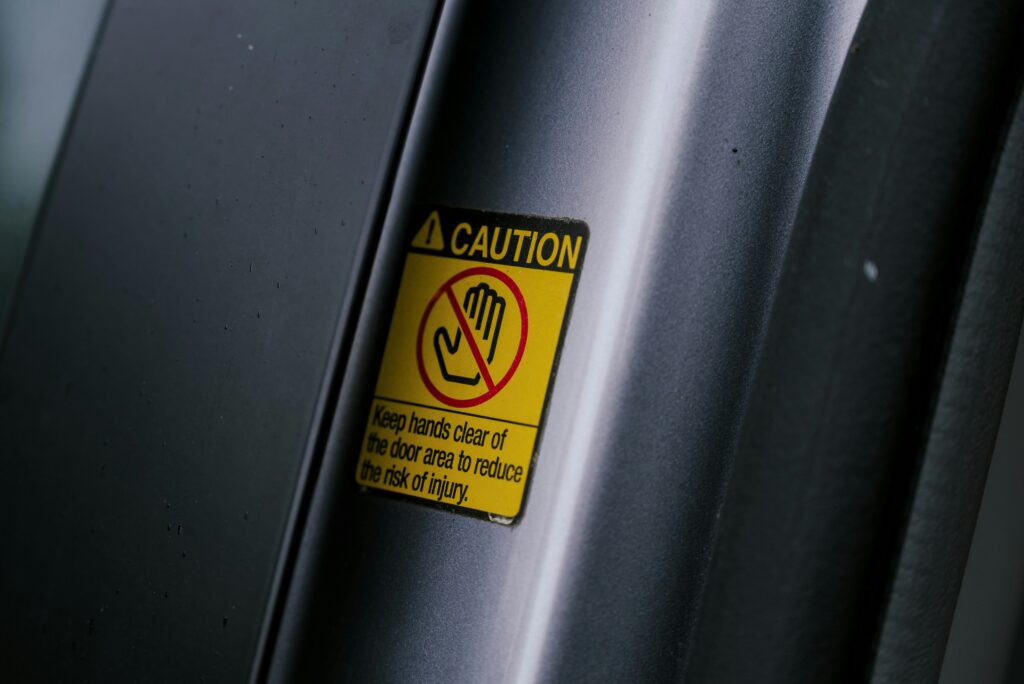Maximise Efficiency in the Auto Industry with Key Labels
Automotive labels drive efficiency within the automotive industry by ensuring accurate tracking, identification, and management of parts and vehicles throughout the supply chain. They facilitate compliance with industry standards, enhancing operational efficiency and reducing errors.

Why are automotive labels important?
Labels are used in the automotive industry to provide essential information about safety standards, regulations, and warnings. They ensure that vehicles and equipment meet legal requirements and that consumers are informed about potential hazards and safety precautions. Labels with unique identifiers, such as serial numbers or barcodes, aid in tracking vehicles throughout their lifecycle. In the event of a recall or safety issue, these labels facilitate efficient identification and notification of affected vehicles.
Odette Labels
Odette labels are standardised labels used in the automotive industry for logistics and supply chain management. Odette stands for “Organisation for Data Exchange by Tele-Transmission in Europe,” an organisation that promotes standards for electronic data interchange (EDI) in the automotive sector.
Odette labels contain essential information related to the shipment of automotive parts and components between manufacturers, suppliers, and distributors. They are applied to packaging, such as boxes, crates, or pallets, to facilitate efficient handling and tracking throughout the supply chain.
Key components of Odette labels may include:
Supplier Information: Details about the supplier or manufacturer sending the shipment, including their name, address, and contact information.
Recipient Information: Information about the recipient or destination of the shipment, including their name, address, and contact details.
Part Number: Identification numbers or codes for the automotive parts or components contained within the shipment.
Quantity: The quantity of parts or components included in the shipment.
Date and Time: Date and time of shipment for tracking and scheduling purposes.
Serial Numbers or Batch Numbers: Unique identifiers for individual parts or batches, aiding in traceability and quality control.
Barcode or QR Code: Machine-readable codes for automated data capture and processing.
Transportation Information: Details about the mode of transportation, carrier information, and any special handling instructions.
Odette labels help streamline logistics operations by providing standardised information in a format that can be easily transmitted and processed electronically. They ensure the efficient movement of automotive parts and components throughout the supply chain, ultimately contributing to cost savings and improved efficiency for automotive manufacturers and suppliers.
RFID and barcode labels
RFID (Radio Frequency Identification) and barcode labels support improved inventory management, enhanced supply chain visibility, and streamlined logistics operations. They can be attached to automotive parts, components, and vehicles to enable real-time tracking throughout the supply chain so that companies can accurately monitor the movement of inventory, from manufacturing facilities to distribution centres and dealerships. By tagging tools, equipment, and machinery, companies can track their location, usage, and maintenance history, reducing losses and optimising asset utilisation.
The right labels can help combat counterfeit automotive parts by providing secure authentication and verification. By embedding unique identification codes or encrypted data in RFID tags, companies can authenticate genuine parts and detect counterfeit or unauthorised products in the supply chain.
RFID technology enables real-time visibility into the movement of goods within the automotive supply chain. By integrating RFID data with ERP systems and SCM software, companies can optimise inventory levels and improve overall supply chain efficiency.
With accurate, up-to-date information on inventory levels and production schedules, automotive manufacturers can synchronise production processes with demand fluctuations, reduce lead times, and minimise excess inventory holding costs.

Different types of labels used in the automotive industry
VIN Labels: Vehicle Identification Number (VIN) labels are affixed to vehicles and contain unique alphanumeric codes identifying individual vehicles. VIN labels are used for registration, insurance, and tracking purposes.
Compliance Labels: These labels display information required for regulatory compliance, such as emissions certifications, safety ratings, and fuel economy data. Compliance labels ensure that vehicles meet legal standards and provide transparency to consumers.
Warning Labels: Warning labels alert users to potential hazards and safety precautions. They may include warnings about airbag deployment, hot surfaces, electrical hazards, and other safety concerns to prevent accidents and injuries.
Instructional Labels: Instructional labels provide guidance on vehicle operation, maintenance, and troubleshooting. They include instructions for tasks such as tyre inflation, battery replacement, fluid checks, and emergency procedures.
Component Labels: Component labels identify specific parts or components within the vehicle, such as engine specifications, tyre information, and fluid capacities. These labels help technicians and owners identify and maintain vehicle components accurately.
QR Code or Barcode Labels: QR codes or barcodes on labels enable easy access to additional information, such as owner’s manuals, service histories, and warranty details. Scanning these codes with a smartphone or barcode reader provides quick access to relevant resources.
Certification Labels: Certification labels indicate that the vehicle or its components meet specific standards or certifications, such as ISO quality standards or industry-specific certifications. These labels instil confidence in the quality and reliability of the vehicle.
Tamper-Evident Labels: Tamper-evident labels deter unauthorised access or tampering with vehicle components, such as odometers or airbags. These labels indicate if a component has been altered or accessed without authorisation.
Service Reminder Labels: Service reminder labels are typically placed on the windshield or dashboard to remind owners of upcoming maintenance tasks, such as oil changes, filter replacements, or inspection intervals.
The future of automotive labelling
The future of labelling in the automotive industry will be characterised by innovation, connectivity, sustainability, and enhanced user experiences. Labels embedded with smart technologies will enable connectivity with IoT (Internet of Things) devices, allowing for real-time tracking, monitoring, and data exchange throughout the vehicle’s lifecycle, from manufacturing to end-of-life disposal.
Labels will play a crucial role in the implementation of digital twin technology in the automotive industry. Labels can facilitate seamless data synchronisation, remote diagnostics, predictive maintenance, and performance optimisation by linking physical vehicles and components with their digital counterparts.
With increasing focus on sustainability and environmental responsibility, automotive labels will continue incorporating eco-friendly materials and printing techniques. Labels made from recycled materials, biodegradable substrates, or renewable resources will become more prevalent, aligning with industry-wide efforts to reduce carbon footprint and promote circular economy principles.
Discover how our Automotive Labels can transform your operations for greater efficiency and compliance. Dive into our comprehensive labelling solutions tailored for the automotive industry today.


















